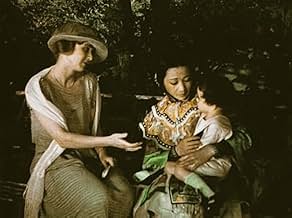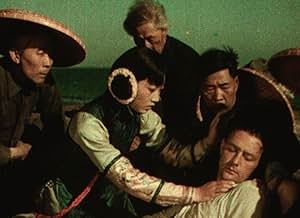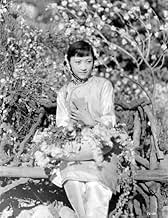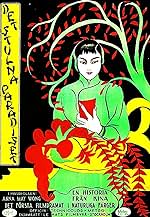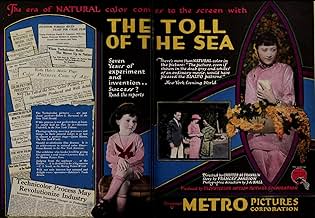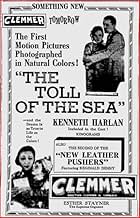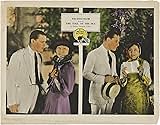While visiting China, an American man falls in love with a young Chinese woman, but he then has second thoughts about the relationship.While visiting China, an American man falls in love with a young Chinese woman, but he then has second thoughts about the relationship.While visiting China, an American man falls in love with a young Chinese woman, but he then has second thoughts about the relationship.
- Awards
- 1 win total
Featured reviews
This 1922 film is apparently the first feature length film ever made in color, which alone makes it worth watching. It stars the beautiful, incomparable Anna May Wong, who was 17 at the time. She already shows remarkable maturity as an actress. The story unfolds when Lotus Flower discovers a Caucasian man floating in the sea and enlists help to save him. They fall in love and get married. Does the love last? This film is very dramatic, and it lasts under one hour. The story is told simply, with interesting twists in the tale. The film was thought lost for years until it was found, with the ending needing to be re shot. See it for the historical, pioneering aspect of it. But, most important, see it for the great performance of Anna May Wong. This movie cements the brilliant and varied versatility that she had as an actress.
This film has a bit of fame as one of the first films using the process of two tone color. I saw it at MOMA when they were showing a retrospective of the history of color in moving pictures. It was shown without any music and for a silent film this is usually death, but the film was utterly engrossing and terribly moving. I still think of it ten years after I've seen it and would LOVE to get my hands on a copy. Anna May Wong is poignant and fragile in the lead role in this adaptation of the Madame Butterfly story.
This beautifully told story was written by Frances Marion, the highest paid and most famous woman screenwriter of the early film days. It is beautifully photographed in color, one of the first. The story loosely follows Madame Butterfly and is tender and touching.
For a long time I only knew of this film for it's historical place as the earliest surviving 2 strip Technicolor film. I was curious to see it but expected little more than an interesting museum piece.
A wonderful surprise then, to discover this version of Madam Butterfly, self produced by Technicolor, is a poignant gem of silent cinema, deserving much wider exposure than it's status as a technical first would indicate.
On the technical side the colour is extremely attractive and well integrated into the story. Unlike some two colour films (The Viking, Show of Shows and King of Jazz) where colour correction is used to bring out blue's which originally photographed as silver grey, "Toll of the Sea" is authentic and unretouched, aside from the final lost sequence which had to be reshot in 1985. Since the process wasn't yet refined for filming in artificial light, the "interiors" in "Toll" are filmed in daylight. This is no drawback, however, since the real exteriors lend the film a freshness lacking from later studio bound works.
Another big plus is that the makers actually cast an Asian actress in the central role, instead of going the route of say Broken Blossoms. Perhaps this was because few actors would risk working on such an experimental project, or perhaps the film makers wanted the film to be as authentic as possible. Either way it gives the film an honesty absent from Hollywood's occasional treatments of such themes.
Sensitive direction and the wonderful performance of Anna May Wong, make this a particularly compelling piece. Although just 19, Wong's acting is both subtle and deeply felt. Witness the devastating moment when he tells her she can't come to America with him. The hurt and pain in Wong's face and eyes, which she bravely covers, could melt the stoniest heart. (I'll definitely keep an eye open for Wong's other work) Her leading man is somewhat stiffer but then his performance fits with the confused character he's playing.
Even if like me, you start watching this for the colour, you'll swiftly be caught up in it's story and by the artistry of it's youthful star.
A wonderful surprise then, to discover this version of Madam Butterfly, self produced by Technicolor, is a poignant gem of silent cinema, deserving much wider exposure than it's status as a technical first would indicate.
On the technical side the colour is extremely attractive and well integrated into the story. Unlike some two colour films (The Viking, Show of Shows and King of Jazz) where colour correction is used to bring out blue's which originally photographed as silver grey, "Toll of the Sea" is authentic and unretouched, aside from the final lost sequence which had to be reshot in 1985. Since the process wasn't yet refined for filming in artificial light, the "interiors" in "Toll" are filmed in daylight. This is no drawback, however, since the real exteriors lend the film a freshness lacking from later studio bound works.
Another big plus is that the makers actually cast an Asian actress in the central role, instead of going the route of say Broken Blossoms. Perhaps this was because few actors would risk working on such an experimental project, or perhaps the film makers wanted the film to be as authentic as possible. Either way it gives the film an honesty absent from Hollywood's occasional treatments of such themes.
Sensitive direction and the wonderful performance of Anna May Wong, make this a particularly compelling piece. Although just 19, Wong's acting is both subtle and deeply felt. Witness the devastating moment when he tells her she can't come to America with him. The hurt and pain in Wong's face and eyes, which she bravely covers, could melt the stoniest heart. (I'll definitely keep an eye open for Wong's other work) Her leading man is somewhat stiffer but then his performance fits with the confused character he's playing.
Even if like me, you start watching this for the colour, you'll swiftly be caught up in it's story and by the artistry of it's youthful star.
The Toll of the Sea draws an audience because it was made in the early two strip Technicolor process. The story is about a Chinese girl named Lotus Flower (Anna May Wong) who finds a man dashed upon the rocks by the sea and rescues him. His name is Allen Carver (Kenneth Harlan) and he is an American. He and Lotus Flower fall in love and get married against the warnings that he will leave her for a white woman. Allen has good intentions until some American friends convince him to leave Lotus Flower behind because an inter-racial marriage would never work. The prophesy comes true, and Allen marries childhood sweetheart Elsie (Beatrice Bentley) in America, leaving Lotus Flower with a baby (Priscilla Moran) and a broken heart.
The story is simple, sad, and poetic with some great acting by Wong. Unfortunately, many of her films are lost or unavailable, but she is always impressive in the roles she is given. Thankfully, the Chinese are portrayed sympathetically with very little stereotyping.
The Technicolor is amazing here. We see mostly green and red, but the costuming and settings are strategically designed to utilize those colors. What results is a breath-taking film.
The end of this film is lost, but it was restored by filming the Pacific Ocean with an original Technicolor camera. The title cards make the ending clear and the loss of footage does not detract from the ending's emotional power.
The story is simple, sad, and poetic with some great acting by Wong. Unfortunately, many of her films are lost or unavailable, but she is always impressive in the roles she is given. Thankfully, the Chinese are portrayed sympathetically with very little stereotyping.
The Technicolor is amazing here. We see mostly green and red, but the costuming and settings are strategically designed to utilize those colors. What results is a breath-taking film.
The end of this film is lost, but it was restored by filming the Pacific Ocean with an original Technicolor camera. The title cards make the ending clear and the loss of footage does not detract from the ending's emotional power.
Did you know
- TriviaThe seventh color feature, the second Technicolor feature, the first color feature made in Hollywood, and the first color feature anywhere that did not require a special projector to be shown.
- Quotes
Old Chinese Gentleman: Whence comes this foreign face?
Lotus Flower: Alone in my garden I heard the cry of wind and wave. I came hurrying fast - and he was here!
Old Chinese Gentleman: Beware of this stranger! The sea is treacherous. His coming bodes no good!
- Alternate versionsIn 1985, this film was restored using original negative materials, by Richard Dayton and Pete Comandini of the YCM Laboratories, and Robert Gitt of the UCLA Film and Television Archives, using funds from the AFI/NEA Film Preservation Program. Because the last 3-minute sequence of the Pacific Ocean was missing, it was re-shot using Frances Marion's titles from her scenario and an authentic 2-strip Technicolor camera. The film ran 53 minutes plus about one minute of explanatory information and restoration credits.
- ConnectionsFeatured in Les premiers pas du cinéma - Un rêve en couleur (2004)
- How long is The Toll of the Sea?Powered by Alexa
Details
- Release date
- Country of origin
- Language
- Also known as
- The Toll of the Sea
- Production company
- See more company credits at IMDbPro
- Runtime54 minutes
- Sound mix
- Aspect ratio
- 1.33 : 1
Contribute to this page
Suggest an edit or add missing content


